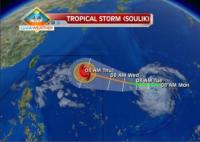3:13 pm | Saturday, July 13th, 2013
TAIPEI—Typhoon Soulik battered Taiwan with torrential rain and powerful winds on Saturday that left one person dead and at least 30 people injured.
This as the typhoon, codenamed “Huaning” in the Philippines, left the country’s area of responsibility Saturday morning, prompting the lifting of all public storm alerts in extreme Northern Luzon.
As daylight dawned, some areas in Taiwan were submerged by flood waters, roofs were ripped from homes, and debris and fallen trees littered the streets.
More heavy rain and strong winds are predicted throughout Saturday with the authorities warning of landslides and further flooding.
More than 8,000 people were evacuated from their homes before the typhoon hit, many from southern areas prone to landslides.
Soldiers have been deployed to high risk areas and the whole island declared an “alert zone” by the authorities.
In the capital Taipei, a 50-year-old police officer died after being hit by bricks that came loose during the typhoon, the Central Emergency Operation Centre said.
Three people were left seriously injured with 31 reported hurt in four cities in northeast Taiwan, most of them hit by trees or flying debris.
Soulik made landfall on the northeast coast around 03 a.m. Saturday (2000 GMT Friday), packing winds of up to 190 kilometers an hour (118 miles), the Central Weather Bureau said.
“We expect Soulik to continue to affect Taiwan with heavy rains and strong winds throughout Saturday across Taiwan even though it is moving away and heading towards China,” a weather forecaster from the bureau told Agence France-Presse.
Nine people had to be rescued from homes in the Shiangshan area of Puli in central Nantou county where flood waters rose one-storey high, according to Wu Yuan-ming, a township official.
“They had to be rescued by firefighters in rubber boats after the river broke its banks. Roads are flooded and mud has been washed into homes — this is more serious than we predicted as there has never been any flooding in Shiangshan before.
“Also an earthquake last month probably loosened the ground and triggered the mudslides,” said Wu.
TV footage showed waist-deep yellow water flowing through the streets of the town of Wufeng, also in Nantou.
The town of Bailan in the north saw the heaviest rain, measuring 900 millimeters (35 inches) over the past two days, with winds gusting up to 220 kilometres per hour.
Streets were submerged under 30 centimeters of seawater in the port city of Keelung, the National Fire Agency said, with flooding also reported in the coastal area of Yilan and in New Taipei City, northwest of the capital.
Low-lying houses along the Hsintien River through greater Taipei were flooded, including one village where residents had been evacuated Friday, a local police officer told AFP.
Local television showed roofs ripped from homes in northern Keelung and in Taipei, where 120 kilometre-per-hour winds and downpours disrupted power, uprooted trees and left the streets strewn with rubbish.
“I was very worried, I couldn’t sleep the whole night because the sound of the wind was so loud and my building was shaking almost like there was an earthquake,” Taipei resident Josephine Lin told AFP.
Across Taiwan, electricity supplies in nearly 800,000 homes cut off by the typhoon but half had been restored by Saturday morning, according to Taiwan Power Company.
Around 170 flights into and out of Taiwan were cancelled or delayed.
Hundreds of passengers on three international flights with Taiwan’s EVA Airways were trapped on their planes for six hours early Saturday, CTI cable news reported. The three aircraft departed later.
Offices and schools remained closed across Taiwan, with the public advised to stay indoors.
In August 2009, Typhoon Morakot killed about 600 people in Taiwan, most of them buried in huge landslides in the south, in one of the worst natural disasters to hit the island in recent years.

A public bus maneuvers through a path of debris from strong winds of Typhoon Soulik early Saturday in Taipei, Taiwan. AP
Follow Us
Recent Stories:
Tags: Huaning , Philippines , Soulik , Taiwan , Typhoon , weather
Factual errors? Contact the Philippine Daily Inquirer’s day desk. Believe this article violates journalistic ethics? Contact the Inquirer’s Reader’s Advocate. Or write The Readers’ Advocate:
![]()

